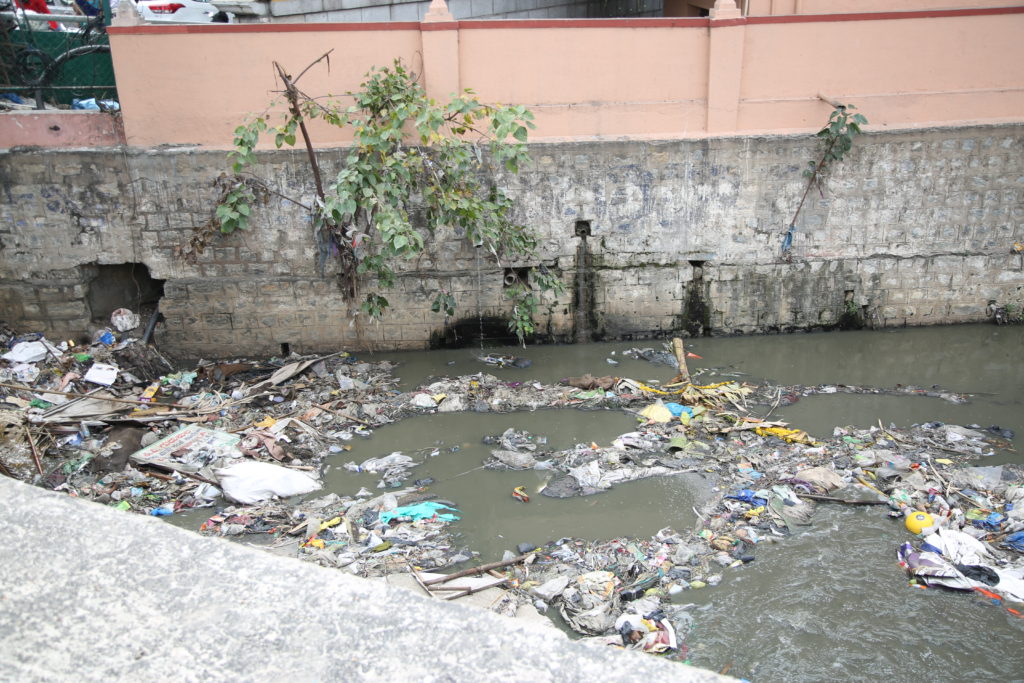What If?
What if you woke up one morning and the pristine, sacred river where you bathed your gods had turned into an oily, noxious-smelling sewer? What if the sacred water started to melt the stone idols of the gods? What if it was undrinkable? What would you do?
Every day at dawn, the 20 year old priest, Srikara Sudharshana, of the Gali Anjaneya temple in the high-tech city of Bengaluru (also known as Bangalore) in south India turns his back on the sacred Vrishabavathi River just beyond his temple walls, and instead fills buckets and bottles with water from the high-end filtration system in the temple. Filtering about 1,000 liters per day, the system makes the water, drawn from a deep well on the temple grounds, potable. Srikara Sudharshana uses the water for the daily ritual bath of the god, and he adds camphor and Tulasi (holy basil) leaves to transform it into thirtha, or holy water, for the devotees to consume.
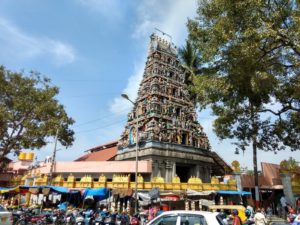
But now, the lush island on which the temple stood is a mere memory. The channel that formed one arm of the river is now a highway — a maelstrom of trucks, cycles, bullock carts, buses, cars and scooters — that swirl by the temple entrance, horns honking and engines revving day and night. And the other arm of the river is a dirty concrete channel where stinking waste-water bubbles and froths behind high concrete walls.
Today, the priests are trapped between the highway and the drain. The burning stench of petrodust from the highway, and the rotten miasma from the drain, float through the temple all the time.
The existential questions that this pollution of the sacred river poses are: how to live when the river is a sewer? And how to survive physically and morally in an ecological, cosmological, and ethical breakdown, exacerbated by anthropogenic intervention?
Water is Divine
For the past several years I have been exploring the relationship between the practice of Hinduism and the sacred landscape of India. In the United States, belief in biblical inerrancy is related to decreased support for environmental protection policies and correlates with a denial of anthropogenic climate change. But at the same time, religious mobilizations are engaging in a variety of social movements supporting climate justice. From Pope Francis’ laudato si to the 2015 “Islamic Declaration on Global Climate Change,” religious leaders and institutions are increasingly calling for action to curb pollution and reduce our carbon footprint.
Moreover, Hinduism is a religion rooted in natural topography. Gods are found in rocks, hillocks, woodlands and trees, rivers and rills. In religious texts and myths, water bodies in particular have an explicit ability to transform space, to extend or truncate time, and, most significantly, to manifest god’s paradoxical nature as simultaneously transcendent and immanent, independent and dependent, formless and formed. In practice, bodies of water are sacred places, held in special regard in processions and festivals not only because they sustain life, but because they are thought to be the seat of the gods.
In Hindu cosmology, the universe is thought to be a vast ocean on which the divine protector Vishnu floats sleepily on his divine serpent bed for eons. His consort Lakshmi, goddess of wealth, emerges seated on a lotus, a perishable flower that grows in water and responds to the sun. These realms of mythic reality instructed generations of Hindus on their custodianship of water resources.
As I learned from my parents and grandparents, and they from generations before them, in Hindu thought river waters represent purity and abundance and connect the twinned worldly and otherworldly landscapes. Rivers like the Vrishabhavathi and Ganges are thought to be Goddesses, made to descend from the heavens by human vows and penances, bringing abundant life to the arid earth of India through their pure waters. Water falling from heaven to earth — the monsoon rains that soak the subcontinent and form rivers and lakes — is conceived of as a material and spiritual bridge between the two realms of life and afterlife. In the Hindu book of death, the Garuda Purana, all souls cross a sacred river in their journey towards the afterlife. Rivers mark the boundaries of sacred worlds, and their waters wash the soul clean.
In short, Hindus valorize water and its flow as a powerful medium of the imagination that shapes space, molds gods and goddesses, and births worshipful communities into existence. It is water, as it is poured ritually over a god during a bath and subsequently drunk by devotees as a consecrated offering, that awakens the god and purifies the devotee. This cycle of water remakes earth into heaven and heaven into earth; and it is part of the fragile cosmological and earthly ecosystem.
For Hindus, the pollution of India’s sacred waters would therefore, one assumes, raise some fundamental questions: Where can and do water gods go when the water is toxically inhospitable? What happens to a religious and moral imagination rooted in the natural world when the ecological landscape is rubbished? What do we do when a river is systematically killed?
Bathing the Gods in Bottled Water
The year 1975 was when Sudarshana’s grandfather remembers last going to the river bank to draw water from the sacred Vrishabhavathi to bathe the deity, drink, and wash the sacred temple vessels. But then the river water started “smelling bad” and became sludgy and grey. With great sadness, he decided he could not use the river water for ritual purification anymore.
Then there were years without rain in the 1980s and 1990s, and water became scarce in the temple and in the city. The priests gathered every morning at dawn to perform ritual invocations to bring the monsoon rains. But none came. The waste water in the channel grew low and the smell became acrid.
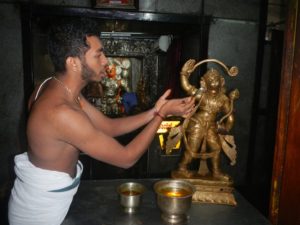
All of this was particularly, and painfully, ironic since one of the legends of the temple involved the gift of floods. During the monsoon rains, the legend went, the river waters would rise and flow into the temple, lapping the feet of the deity in small wavelets, a sign from the gods that it would be a bountiful year for the crops as the river silt spread all over the valley through the network of lakes and streams.
Today, monsoon season turns the temple into a hive of activity as priests and officiants anxiously build sand bag levees and quickly connect sump pumps and hoses to prevent the toxic river waters from entering the temple premises. In Bengaluru’s historic floods in 2017, when the river started to rise, the priests had to sweep away the toxic sludge all day and night, working with brooms and mops, for fear the water would slime the entire temple and dump toxic waste on the deity.
The priests watch the river with anxiety now. The flood is no longer a divine gift but a feared curse. Srikara Sudarshana and his fellow priests are, quite simply, afraid of the water.
Killing the River
The story of the Vrishabhavathi’s transformation, from pure bubbling sacred stream to its present incarnation as a stinking “nala,” or drainage channel for solid waste, is the stuff of Srikara Sudharshana’s nightmares.
Ancient stone edicts and colonial documents of the region mention the sparkling river Vrishabhavathi — “rising from a bull’s hoof” — as originating from the hoof of an ancient, sacred, monolithic bull sculpture in the south of the city. Another, lesser-known origin point of the river was a temple tank with an eternal stream also dedicated to the sacred bull, in the north of the city. After being forgotten for decades, the temple tank was accidentally unearthed in the late 1990s, when I happened to be in the city exploring the idea of wonder through ritual activity.
Until the 18th century when the city was young, the river’s many tributaries, streams and rills formed a watery network as they flowed through Bengaluru, irrigating fields and providing drinking water for the inhabitants. But by the late 19th century, the city was a colonial center, and the river was mapped, dammed, and rechanneled by British colonial administrators to provide water for the mills and military encampments they located in Bengaluru.
With Indian Independence in 1947, Bengaluru became a growing center of science and technology development, manufacturing everything from rocket ships to watches. Today, Bengaluru is one of the fastest growing cities in Asia, home to the Tech industry, the “Silicon Valley” of India, and tagged number one as the “most dynamic city” by the World Economic Forum. Ringed by clogged highways leading to steel and glass “software parks” housing the global campuses of Fortune 500 companies, Bengaluru has doubled in size in 20 years, to over 12 million inhabitants. Bengaluru’s smokeless success, based on attracting global information and biotech companies, has been retold so frequently that it has taken on a magical, mythic quality of its own.
This growth has attracted migrants to Bengaluru and created conflicts between“newcomers,” who outnumber“locals”in the urban neighborhoods all over the city. To cater to these migrants, small industries and businesses such as car repair shops, beauty shops, restaurants, printing businesses, paper mills, cloth mills, chemical plants, plywood and soap factories, tanneries and distilleries, have sprung up everywhere. They are often unlicensed and unregulated.
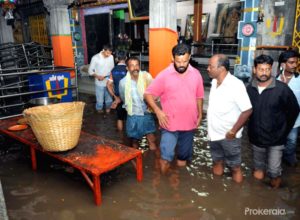
Flooded temple
The Bengaluru Water Supply and Sewerage Board, overburdened by the city’s waste, has thoughtlessly connected the sewer lines to the river. Taking their cue from the city, the factories along the river’s banks in the Peenya Industrial estate upriver, silently release their effluents into the water at night, while they deny culpability to ecological watchdog groups in the day. Samples of water from the channel reveal evidence of heavy metals, toxic substances, and acids causing health concerns. Dead fish float on the dying river, and feral dogs roam its charred banks.
As city ecologist Harini Nagendra notes, these heartbreaking ecological violences including polluting of ground water, cutting of trees, water theft, and an escalating cycle of flood and drought, are leading to extreme water scarcity in Bengaluru. The city is predicted to face a water crisis of epic and incendiary proportions — a day zero when the water taps in the city are predicted to run dry) — in two short years.
This ecological evisceration of sacred water bodies is a global scourge that has accompanied development. Industrial capitalism, as sociologist Max Weber argued, relies on an extractive ethos that strips the world of its supernatural dimensions. Indeed, it seems that capitalism and development are stronger even than the divine power of Hindu gods and goddesses. Capitalism has rendered the priests’ rituals impotent and encouraged political corruption. With development there has been a loss of resources, of community stakeholdership, of responsibility, and of autonomy. And both together have made the waters of the Vrishabhavathi river undrinkable.
The Moral Justice of Thirst
A time of thirst is upon us all. Urban water scarcity is the biggest crisis of the Anthropocene. Cities with a majority poor population like Cape Town and Flint, and those that are growing rapidly like Los Angeles, Bengaluru, Beijing and London, are on the path to ongoing drought or violent floods. As Anna Tsing notes, we all live in a “disturbance regime” of “blasted landscapes.” The World Wildlife Fund estimates that by 2025 two thirds of the world population will face severe water shortages. The urgency of climate justice and water security concerns are obvious and looming.
On June 19, 2018, the National Institute for Transforming India (NITI), an Indian Government think tank, warned that India’s water shortage will worsen and is likely to adversely impact some 600 million people, most of them women and the poor. By 2030, India (home to one seventh of the world’s population) stands to double its yet unmet water needs. Water wars will undoubtedly erupt between those who have access to clean water and those who don’t, those who pollute common water sources like the Vrishabhavathi river and those who rely on them.
Today, the Vrishabhavathi river froths daily, its greenish-yellow suds popping, its banks squelchy with dark fluids. Residents south of the nala, who used to till small market gardens of vegetables in the water, now report falling ill frequently with gasteroenteritis, bronchitis, skin diseases, coughs and other lung diseases. They make sure their animals don’t go into the river. And nobody dares drink from the sacred river, regardless of how thirsty they might be.
Are we now in a permanently thirsty, fiery, post-ecological epoch as Greta Thunberg suggested at Davos 2020? Are we heading towards a post-life era? Can we begin the moral work of undoing toxic development?
Temples to Rubbish
Bengaluru is not an exception; all of India has a toxicity problem. Its cities quiver with mountains of rubbish, and its lakes, rivers and streams are awash with factory pollutants, detergent runoff and sewage sludge. At its inception, the Modi government used this encroaching dirt as a potent symbol, suggesting we “wipe India clean” with their Swach Bharath campaign to make India “clean and pure” in the 21st century. Photo ops of ministers symbolically sweeping city streets flooded the newspapers.
But six years since the Modi government took office, little has been done. Every day, new stories of land thieves and water pirates make headlines in newspapers as the commons are privatized for profit, particularly the forests and waters owned or utilized by poor and lower caste groups.
In the general election in 2018, the Modi government won a resounding majority by ignoring rising pollution. Rather, they politicized the scarcity of water resources as a soul-of-the-nation battle with Pakistan, and instead of focusing on the protection of Indian air and water resources —ecological custodianship implicit in Hinduism’s great myths and epics — the government focused their blunt policies on Indian prosperity and development amid proud calls for “a new India” — an exclusively Hindu nation where non-Hindus would be marginalized—a Swacch Bharath of a different sort.
What Then?
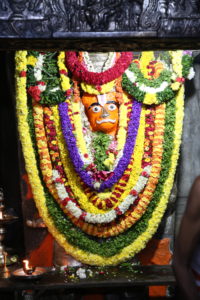
In this chaotic world, the gods become more important. People pray, more fearful and uncertain of the future. In November 2019, an article in The Economic Times went viral with photos of devotees praying, knee deep in the Yamuna river near the capital city of Delhi, surrounded by growing clouds of toxic foam. At the same time, the air pollution in North India was so extreme that devotees dressed their deities in air filtration masks.
Is it surprising then, that in this new India, people are falling chronically ill? Is it surprising that the goddesses of water such as Ganga, and gods of the air like Vayu, are choking and sick? Maybe in this new India, the Hindu gods and goddesses will decide it just isn’t worth staying.
What then?
The Waters of Hope
I confess, I have family and friends who are torn over what they see as eroding Hindu pride. For in this new India, Hinduism is relegated to performing endless elaborate rituals and expressing a divisive, nationalistic rhetoric. It is not a vital theological or dynamic ecological construct, but a cramped and angry political and ideological tool used to (once more) divide neighbors and friends.
But now in this undeniably fulcrum moment I ask, could it be an opportunity to think of a different way to revitalize Hindu pride? Is it time to recognize that the waters and air of the earth are cosmological forces that, once spoiled, are irretrievable, and that in their presence they give and sustain life? Can these waters quench the fires of hatred and distrust, birth hope and flow to justice instead?
Indeed, I am hopeful that Hinduism can offer us a new imaginative geo-political theology for this growing eco-apocalypse. Hinduism can propose a language to think of this eco-catastrophe in religious terms, without being fatalistic or exclusionary. For the very essence of Hinduism— that of earthly custodianship and ecological care — is beyond any single religion, and vitalizes a pan-Indian culture that can emancipate us from the dangers of unthinking development and discrimination.
Tulasi Srinivas is Professor of Anthropology, Religion and Transnational Studies at Emerson College in Boston. She is the author of several monographs including most recently, The Cow in the Elevator: An Anthropology of Wonder (Duke University press, 2018). Her current research project is The Missing Goddess: Women, Water and Violence in Urban India. She has held recent fellowships at the Radcliffe Institute and the Luce-American Council of Learned Societies.
***
https://therevealer.org/bathing-the-gods-in-bottled-water-an-account-of-climate-change-and-faith/.
